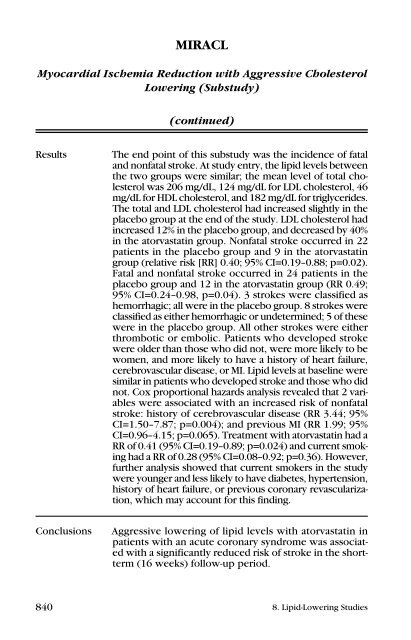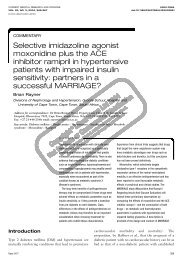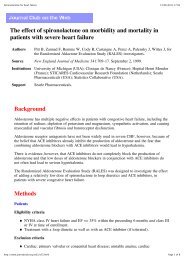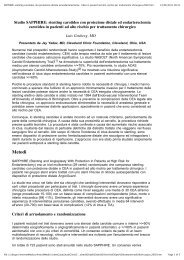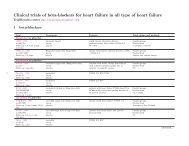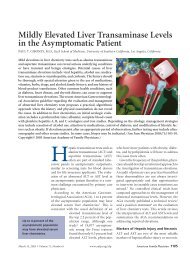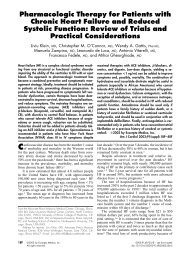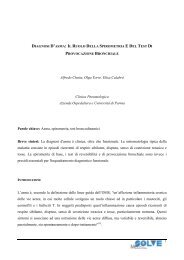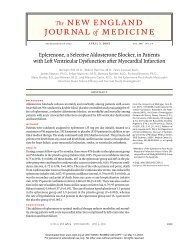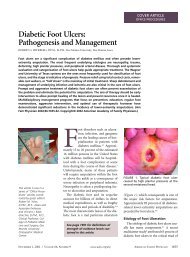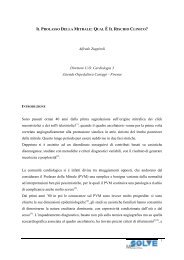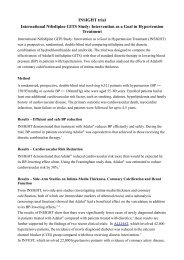Cardiovascular Trials Review Cardiovascular Trials Review - Diegori.it
Cardiovascular Trials Review Cardiovascular Trials Review - Diegori.it
Cardiovascular Trials Review Cardiovascular Trials Review - Diegori.it
Create successful ePaper yourself
Turn your PDF publications into a flip-book with our unique Google optimized e-Paper software.
MIRACL<br />
Myocardial Ischemia Reduction w<strong>it</strong>h Aggressive Cholesterol<br />
Lowering (Substudy)<br />
(continued)<br />
Results<br />
Conclusions<br />
The end point of this substudy was the incidence of fatal<br />
and nonfatal stroke. At study entry, the lipid levels between<br />
the two groups were similar; the mean level of total cholesterol<br />
was 206 mg/dL, 124 mg/dL for LDL cholesterol, 46<br />
mg/dL for HDL cholesterol, and 182 mg/dL for triglycerides.<br />
The total and LDL cholesterol had increased slightly in the<br />
placebo group at the end of the study. LDL cholesterol had<br />
increased 12% in the placebo group, and decreased by 40%<br />
in the atorvastatin group. Nonfatal stroke occurred in 22<br />
patients in the placebo group and 9 in the atorvastatin<br />
group (relative risk [RR] 0.40; 95% CI=0.19–0.88; p=0.02).<br />
Fatal and nonfatal stroke occurred in 24 patients in the<br />
placebo group and 12 in the atorvastatin group (RR 0.49;<br />
95% CI=0.24–0.98, p=0.04). 3 strokes were classified as<br />
hemorrhagic; all were in the placebo group. 8 strokes were<br />
classified as e<strong>it</strong>her hemorrhagic or undetermined; 5 of these<br />
were in the placebo group. All other strokes were e<strong>it</strong>her<br />
thrombotic or embolic. Patients who developed stroke<br />
were older than those who did not, were more likely to be<br />
women, and more likely to have a history of heart failure,<br />
cerebrovascular disease, or MI. Lipid levels at baseline were<br />
similar in patients who developed stroke and those who did<br />
not. Cox proportional hazards analysis revealed that 2 variables<br />
were associated w<strong>it</strong>h an increased risk of nonfatal<br />
stroke: history of cerebrovascular disease (RR 3.44; 95%<br />
CI=1.50–7.87; p=0.004); and previous MI (RR 1.99; 95%<br />
CI=0.96–4.15; p=0.065). Treatment w<strong>it</strong>h atorvastatin had a<br />
RR of 0.41 (95% CI=0.19–0.89; p=0.024) and current smoking<br />
had a RR of 0.28 (95% CI=0.08–0.92; p=0.36). However,<br />
further analysis showed that current smokers in the study<br />
were younger and less likely to have diabetes, hypertension,<br />
history of heart failure, or previous coronary revascularization,<br />
which may account for this finding.<br />
Aggressive lowering of lipid levels w<strong>it</strong>h atorvastatin in<br />
patients w<strong>it</strong>h an acute coronary syndrome was associated<br />
w<strong>it</strong>h a significantly reduced risk of stroke in the shortterm<br />
(16 weeks) follow-up period.<br />
840 8. Lipid-Lowering Studies


